
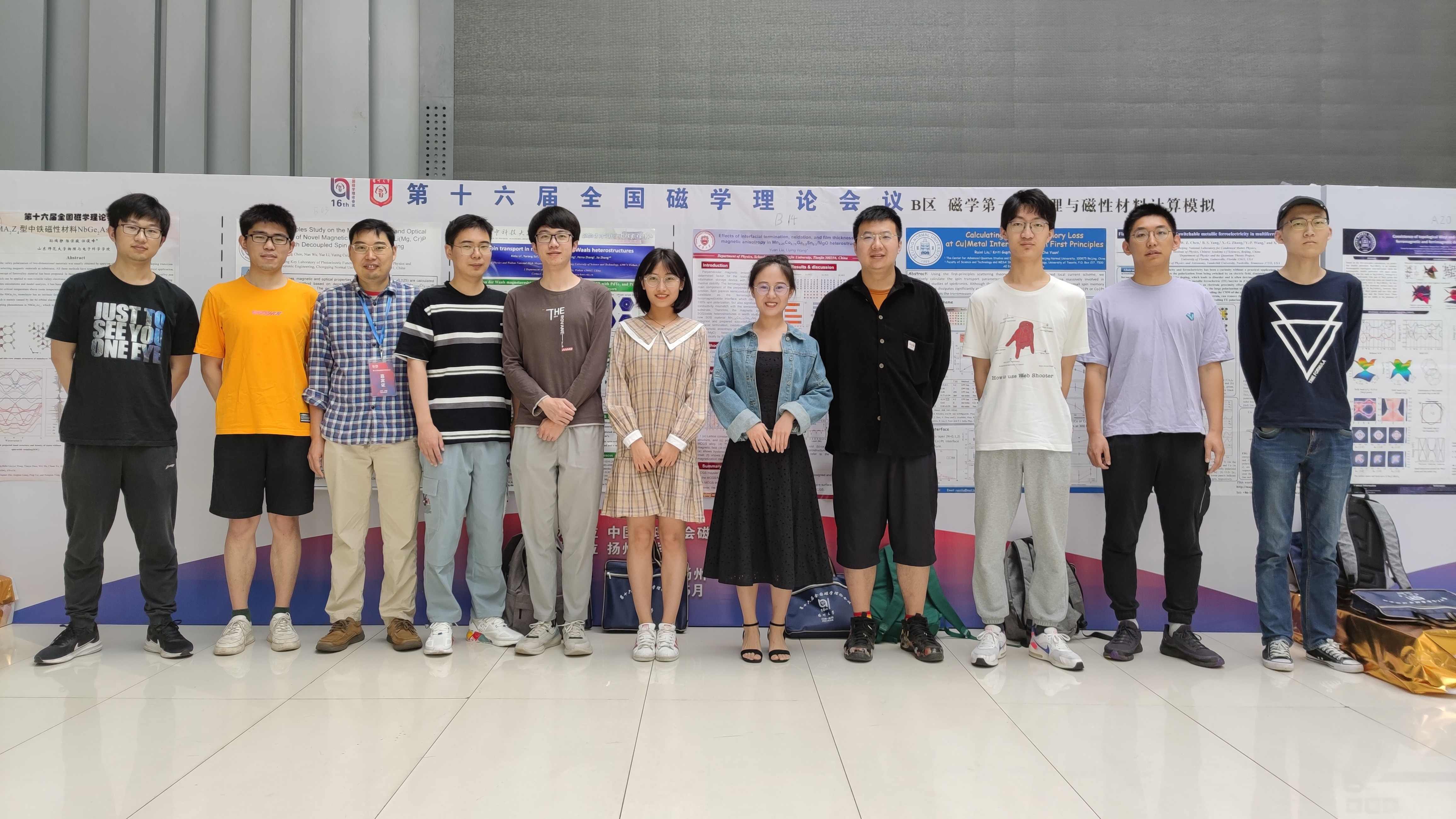
Updates
________________________________________________________________________________________________________________________________________________________________________________
2020-09-17
Strong interface-induced spin-charge conversion in YIG/Cr heterostructures
In collaboration with Prof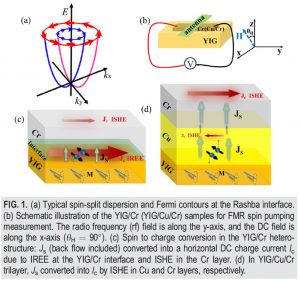 . Yongbing Xu’s group in School of Electronic Science and Engineering, Nanjing University, and Dr. Bo Liu, and Dr. Hao Meng in Key Laboratory of Spintronics Materials, Devices and Systems of Zhejiang Province, we recently published a paper entitled “Strong interface-induced spin-charge conversion in YIG/Cr heterostructures” in APL [Lijun Ni, Zhendong Chen, Xianyang Lu*, Yu Yan, Lichuan Jin, Jian Zhou, Wencheng Yue, Zhe Zhang, Longlong Zhang, Wenqiang Wang, Yong-Lei Wang, Xuezhong Ruan, Wenqing Liu, Liang He, Rong Zhang, Huaiwu Zhang, Bo Liu, Ronghua Liu*, Hao Meng*, and Yongbing Xu*, Appl. Phys. Lett. 117, 112402 (2020)]. Congratulations to Ms. Lijun Ni. In this work, we have investigated the spin pumping effect of Y3Fe5O12 (YIG)/Cu (t_Cu nm)/Cr heterostructures with the thickness of the Cu interlayer varying from 0.4 nm to 5.0 nm by using our home-made CPW broadband FMR spectroscopy. A huge charge signal I_c = 0.239 uA is observed in a YIG/Cr bilayer with direct contact, whereas I_c drops dramatically by two orders of magnitude when thin Cu interlayers down to 0.4 nm are inserted between YIG and Cr. Meanwhile, the injected spin current J_s stays almost invariant for all the heterostructures. The effective spin Hall angle of the YIG/Cr interface is found to be three orders of magnitude larger than the spin Hall angle of the bulk Cr layer in YIG/Cu/Cr. The huge spin-charge conversion efficiency at the YIG/Cr interface is attributed to the inverse Rashba–Edelstein effect. Our experimental results demonstrate the dominant role of the interfacial effect in the spin-charge conversion process of the YIG/Cr heterostructures, suggesting that tailoring the interface of magnetic heterostructures provides an alternative strategy to achieve the higher spin-charge conversion efficiency for the development of low-power consumption spintronic devices. This paper was also selected as an Editor’s Pick.
. Yongbing Xu’s group in School of Electronic Science and Engineering, Nanjing University, and Dr. Bo Liu, and Dr. Hao Meng in Key Laboratory of Spintronics Materials, Devices and Systems of Zhejiang Province, we recently published a paper entitled “Strong interface-induced spin-charge conversion in YIG/Cr heterostructures” in APL [Lijun Ni, Zhendong Chen, Xianyang Lu*, Yu Yan, Lichuan Jin, Jian Zhou, Wencheng Yue, Zhe Zhang, Longlong Zhang, Wenqiang Wang, Yong-Lei Wang, Xuezhong Ruan, Wenqing Liu, Liang He, Rong Zhang, Huaiwu Zhang, Bo Liu, Ronghua Liu*, Hao Meng*, and Yongbing Xu*, Appl. Phys. Lett. 117, 112402 (2020)]. Congratulations to Ms. Lijun Ni. In this work, we have investigated the spin pumping effect of Y3Fe5O12 (YIG)/Cu (t_Cu nm)/Cr heterostructures with the thickness of the Cu interlayer varying from 0.4 nm to 5.0 nm by using our home-made CPW broadband FMR spectroscopy. A huge charge signal I_c = 0.239 uA is observed in a YIG/Cr bilayer with direct contact, whereas I_c drops dramatically by two orders of magnitude when thin Cu interlayers down to 0.4 nm are inserted between YIG and Cr. Meanwhile, the injected spin current J_s stays almost invariant for all the heterostructures. The effective spin Hall angle of the YIG/Cr interface is found to be three orders of magnitude larger than the spin Hall angle of the bulk Cr layer in YIG/Cu/Cr. The huge spin-charge conversion efficiency at the YIG/Cr interface is attributed to the inverse Rashba–Edelstein effect. Our experimental results demonstrate the dominant role of the interfacial effect in the spin-charge conversion process of the YIG/Cr heterostructures, suggesting that tailoring the interface of magnetic heterostructures provides an alternative strategy to achieve the higher spin-charge conversion efficiency for the development of low-power consumption spintronic devices. This paper was also selected as an Editor’s Pick.
________________________________________________________________________________________________________________________________________________________________________________
2020-07-28
Mode Structures and Damping of Quantized Spin Waves in Ferromagnetic Nanowires
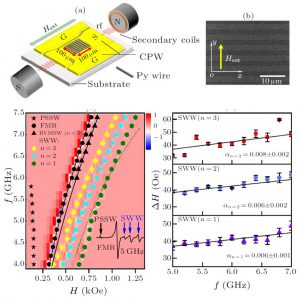 Magnonic devices based on spin waves are considered as a new generation of energy-efficient and high-speed devices for storage and processing of information. Our new work entitled “Mode Structures and Damping of Quantized Spin Waves in Ferromagnetic Nanowires” is published in Chinese Physical Letter [Qingwei Fu1, Yong Li2, Lina Chen1, Fusheng Ma2, Haotian Li1, Yongbing Xu3,4, Bo Liu5, Ronghua Liu1*, Chin. Phys. Lett. 37, 087503(2020)]. Congratulations to Mr. Qingwei Fu. In this work, we experimentally demonstrate that three distinct dominated magneto-dynamic modes are excited simultaneously and coexist in a transversely magnetized ferromagnetc wire by combining our home-made CPW broadband FMR spectroscopy and electron beam lithography technique. Besides the uniform FMR mode, the spin-wave well mode, the backward volume magnetostatic spin-wave mode, and the perpendicular standing spin-wave mode are experimentally observed and further confirmed with more detailed spatial profiles by micromagnetic simulation. Furthermore, our experimental approach can also access and reveal damping coefficients of these spin-wave modes. Our results make further insight into the complexity of the dynamical magnetization states in microscale confined FWs, which offers valuable information regarding the excitation of spin waves for the development of magnonic devices. This work is collaborated with Prof. Fusheng Ma’s group, School of Physics and Technology, Nanjing Normal University; Prof. Yongbing Xu in School of Electronic Science and Engineering, Nanjing University, and Dr. Bo Liu in Key Laboratory of Spintronics Materials, Devices and Systems of Zhejiang Province. We especially want to thank Prof. Fusheng Ma and Mr. Yong Li for providing their support in micromagnetic simulation.
Magnonic devices based on spin waves are considered as a new generation of energy-efficient and high-speed devices for storage and processing of information. Our new work entitled “Mode Structures and Damping of Quantized Spin Waves in Ferromagnetic Nanowires” is published in Chinese Physical Letter [Qingwei Fu1, Yong Li2, Lina Chen1, Fusheng Ma2, Haotian Li1, Yongbing Xu3,4, Bo Liu5, Ronghua Liu1*, Chin. Phys. Lett. 37, 087503(2020)]. Congratulations to Mr. Qingwei Fu. In this work, we experimentally demonstrate that three distinct dominated magneto-dynamic modes are excited simultaneously and coexist in a transversely magnetized ferromagnetc wire by combining our home-made CPW broadband FMR spectroscopy and electron beam lithography technique. Besides the uniform FMR mode, the spin-wave well mode, the backward volume magnetostatic spin-wave mode, and the perpendicular standing spin-wave mode are experimentally observed and further confirmed with more detailed spatial profiles by micromagnetic simulation. Furthermore, our experimental approach can also access and reveal damping coefficients of these spin-wave modes. Our results make further insight into the complexity of the dynamical magnetization states in microscale confined FWs, which offers valuable information regarding the excitation of spin waves for the development of magnonic devices. This work is collaborated with Prof. Fusheng Ma’s group, School of Physics and Technology, Nanjing Normal University; Prof. Yongbing Xu in School of Electronic Science and Engineering, Nanjing University, and Dr. Bo Liu in Key Laboratory of Spintronics Materials, Devices and Systems of Zhejiang Province. We especially want to thank Prof. Fusheng Ma and Mr. Yong Li for providing their support in micromagnetic simulation.
_________________________________________________________________________________________________________________________________________________________________________________
2020-04-27
Spin Pumping of polycrystalline YIG/Pt grown on silicon wafers
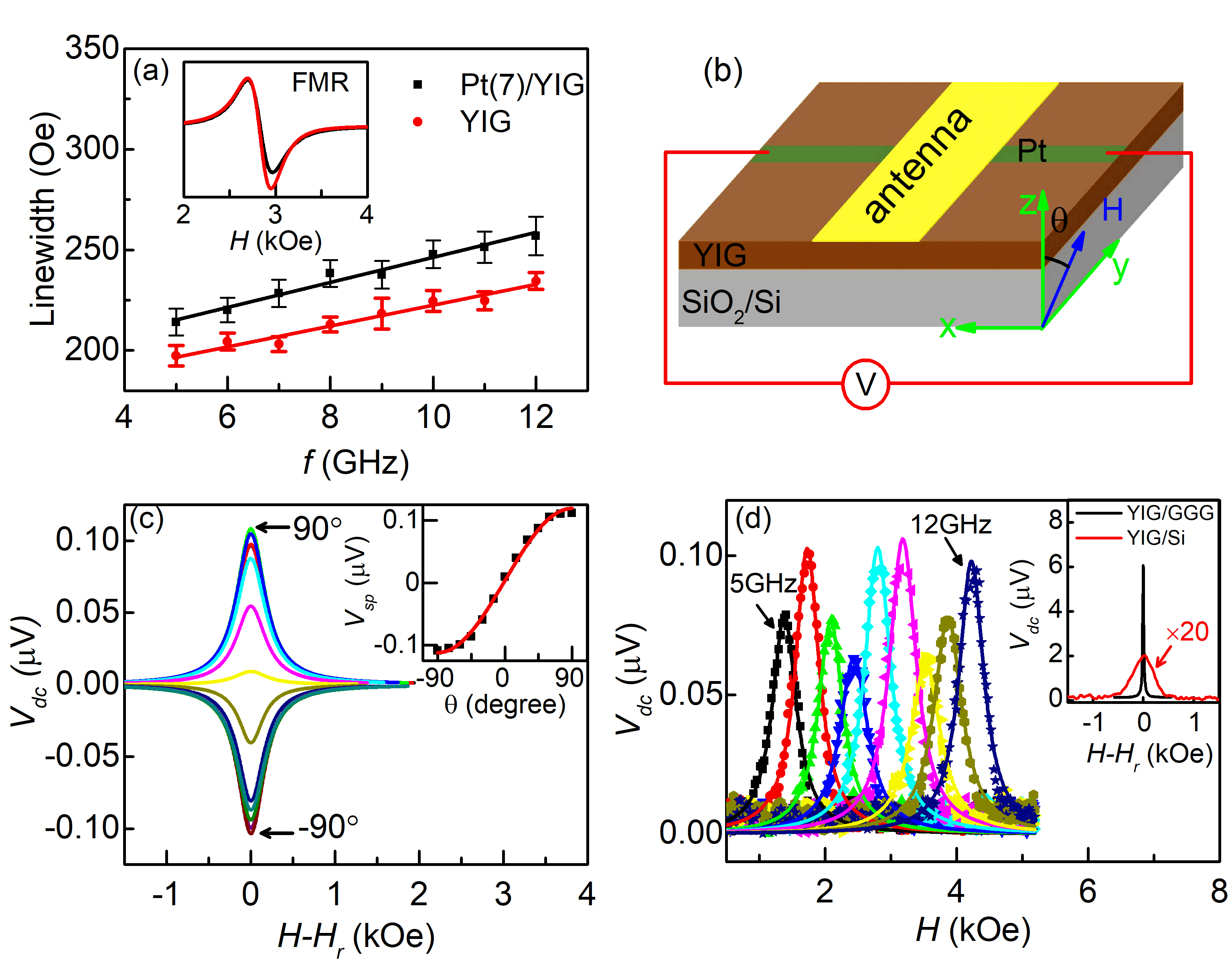 Our new work entitled “Electrical generation and detection of spin waves in polycrystalline YIG/Pt grown on silicon wafers” is published in Materials Research Express [Rongxin Xiang, Lina Chen*, Sheng Zhang, Haotian Li, J. Du, Y. W. Du, and R.H. Liu*, Materials Research Express 7, 046105 (2020)]. Congratulations to Mr. Xiang. In this work, we studied the magnetic properties of polycrystalline Y3Fe5O12 (YIG) thin films (less than 100 nm) deposited on thermally oxidized silicon wafer by our home-made magnetron sputtering (<10-9 Torr, DIY UHV sputtering guns) and followed by the post-annealing process. We found that sputtering at room temperature combined with the post-annealing treatment can be an efficient method to achieve large-area (inch scale) and highly uniform YIG thin films with a low damping constant α ~ 7 ×10-3 on cheap oxidized Si wafer. The dynamical properties of the YIG thin films are characterized by our home-made CPW broadband FMR spectroscopy (10 MHz – 40 GHz, 4 K – 350 K, ± 2 T). Furthermore, the spin pumping experiments demonstrate that the polycrystalline YIG/Pt system has a good spin mixing conductance, where spin current can be effectively injected into the adjacent Pt layer from YIG through the interface. Then the electrical detection of magnetic properties (e.g., spin waves) of insulating YIG film can be achieved via the inverse spin Hall effect of Pt. The electrical detection of spin waves in the large-area polycrystalline YIG/Pt on silicon wafer may help to develop new spintronic devices (e.g., magnon-based devices) by utilizing the complementary metal-oxide-semiconductor (CMOS) technology. We thank Prof. Jun Du in our Department of Physics for his support in measurements and analysis of magnetic susceptibility.
Our new work entitled “Electrical generation and detection of spin waves in polycrystalline YIG/Pt grown on silicon wafers” is published in Materials Research Express [Rongxin Xiang, Lina Chen*, Sheng Zhang, Haotian Li, J. Du, Y. W. Du, and R.H. Liu*, Materials Research Express 7, 046105 (2020)]. Congratulations to Mr. Xiang. In this work, we studied the magnetic properties of polycrystalline Y3Fe5O12 (YIG) thin films (less than 100 nm) deposited on thermally oxidized silicon wafer by our home-made magnetron sputtering (<10-9 Torr, DIY UHV sputtering guns) and followed by the post-annealing process. We found that sputtering at room temperature combined with the post-annealing treatment can be an efficient method to achieve large-area (inch scale) and highly uniform YIG thin films with a low damping constant α ~ 7 ×10-3 on cheap oxidized Si wafer. The dynamical properties of the YIG thin films are characterized by our home-made CPW broadband FMR spectroscopy (10 MHz – 40 GHz, 4 K – 350 K, ± 2 T). Furthermore, the spin pumping experiments demonstrate that the polycrystalline YIG/Pt system has a good spin mixing conductance, where spin current can be effectively injected into the adjacent Pt layer from YIG through the interface. Then the electrical detection of magnetic properties (e.g., spin waves) of insulating YIG film can be achieved via the inverse spin Hall effect of Pt. The electrical detection of spin waves in the large-area polycrystalline YIG/Pt on silicon wafer may help to develop new spintronic devices (e.g., magnon-based devices) by utilizing the complementary metal-oxide-semiconductor (CMOS) technology. We thank Prof. Jun Du in our Department of Physics for his support in measurements and analysis of magnetic susceptibility.
_________________________________________________________________________________________________________________________________________________________________________________
2020-02-13
Achieve a new type of spin Hall nano-oscillator
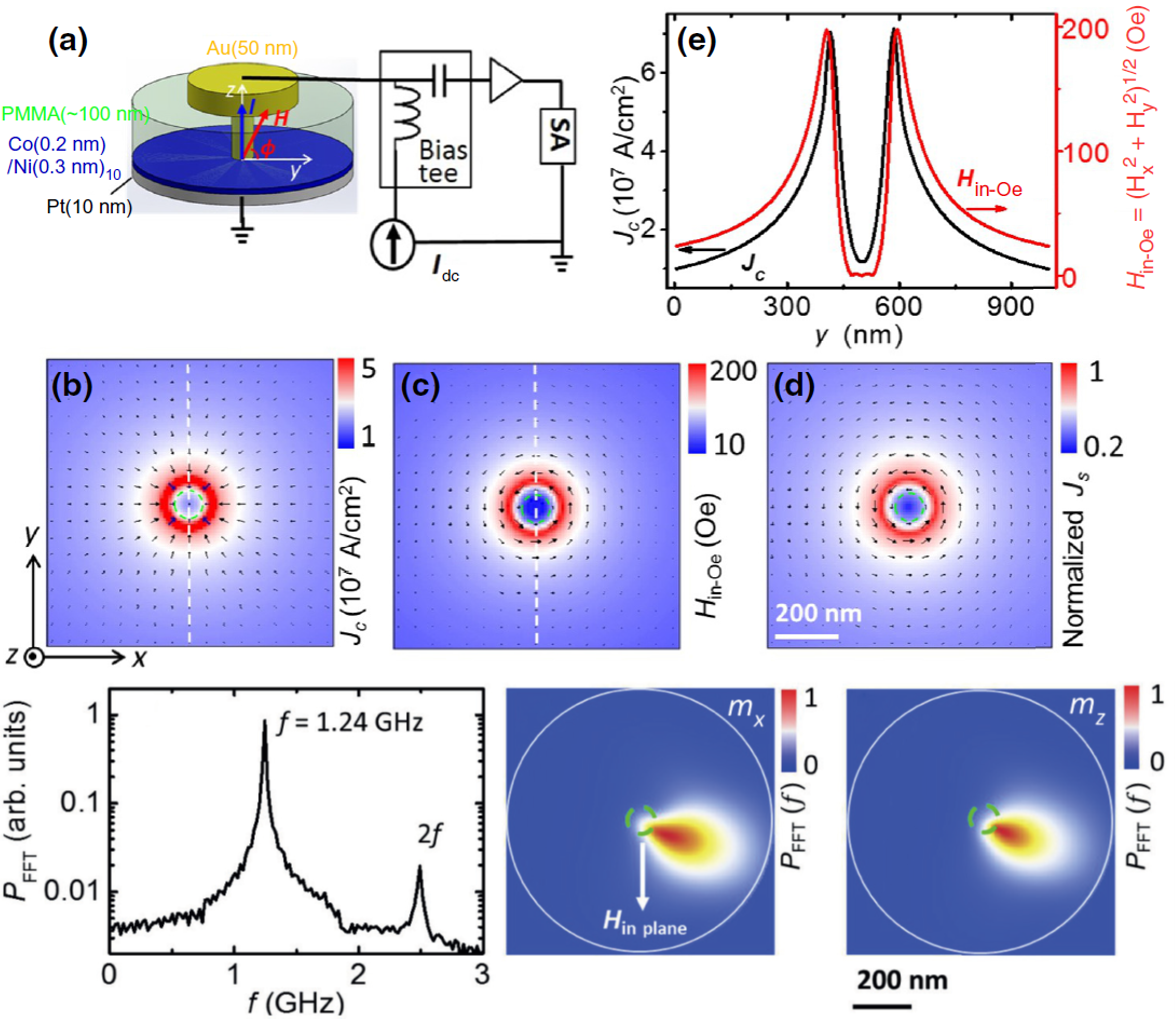 Our new work entitled “Magnetic droplet mode in a vertical nanocontact-based spin Hall nano-oscillator at oblique fields” is published in Physical Review Applied [Lina Chen, S. Urazhdin, Kaiyuan Zhou, Y. W. Du, and R. H. Liu*, Phys. Rev. Applied 13, 024034 (2020)]. Congratulations to Dr. Chen. In this paper, we experimentally demonstrate an alternative type of spin Hall nano-oscillator based on a vertical nanocontact fabricated on a Pt/(Co/Ni) multilayer. We analyze the spectral characteristics of the nano-oscillator as a function of current, magnetic field, and temperature. At sufficiently large currents, the oscillator exhibits dynamics at a frequency far below the ferromagnetic resonance, which at large fields exhibits a redshift with increasing current. At smaller fields and low temperatures, the frequency becomes nearly independent of current, with a well-defined threshold current. These distinct spectral characteristics of the demonstrated nano-oscillator can be explained by the formation of the magnetic droplet—a dissipative magnetic soliton stabilized by the local injection of spin current produced by the spin Hall effect in Pt. The minimum linewidth exhibits a linear temperature dependence, suggesting single-mode dynamics, and enabling coherent magnetization auto-oscillation at room temperature. The demonstrated nano-oscillator geometry provides alternative opportunities for the development of active nanomagnetic devices and for optimization of their spectral characteristics for applications in microwave technology and spin-wave logic. This work is collaborated with Prof. Sergei Urazhdin, Department of Physics, Emory Universty, USA.
Our new work entitled “Magnetic droplet mode in a vertical nanocontact-based spin Hall nano-oscillator at oblique fields” is published in Physical Review Applied [Lina Chen, S. Urazhdin, Kaiyuan Zhou, Y. W. Du, and R. H. Liu*, Phys. Rev. Applied 13, 024034 (2020)]. Congratulations to Dr. Chen. In this paper, we experimentally demonstrate an alternative type of spin Hall nano-oscillator based on a vertical nanocontact fabricated on a Pt/(Co/Ni) multilayer. We analyze the spectral characteristics of the nano-oscillator as a function of current, magnetic field, and temperature. At sufficiently large currents, the oscillator exhibits dynamics at a frequency far below the ferromagnetic resonance, which at large fields exhibits a redshift with increasing current. At smaller fields and low temperatures, the frequency becomes nearly independent of current, with a well-defined threshold current. These distinct spectral characteristics of the demonstrated nano-oscillator can be explained by the formation of the magnetic droplet—a dissipative magnetic soliton stabilized by the local injection of spin current produced by the spin Hall effect in Pt. The minimum linewidth exhibits a linear temperature dependence, suggesting single-mode dynamics, and enabling coherent magnetization auto-oscillation at room temperature. The demonstrated nano-oscillator geometry provides alternative opportunities for the development of active nanomagnetic devices and for optimization of their spectral characteristics for applications in microwave technology and spin-wave logic. This work is collaborated with Prof. Sergei Urazhdin, Department of Physics, Emory Universty, USA.
_________________________________________________________________________________________________________________________________________________________________________________
2019-11-06
A new computational approach – Neuromorphic computing using spinctronic devices
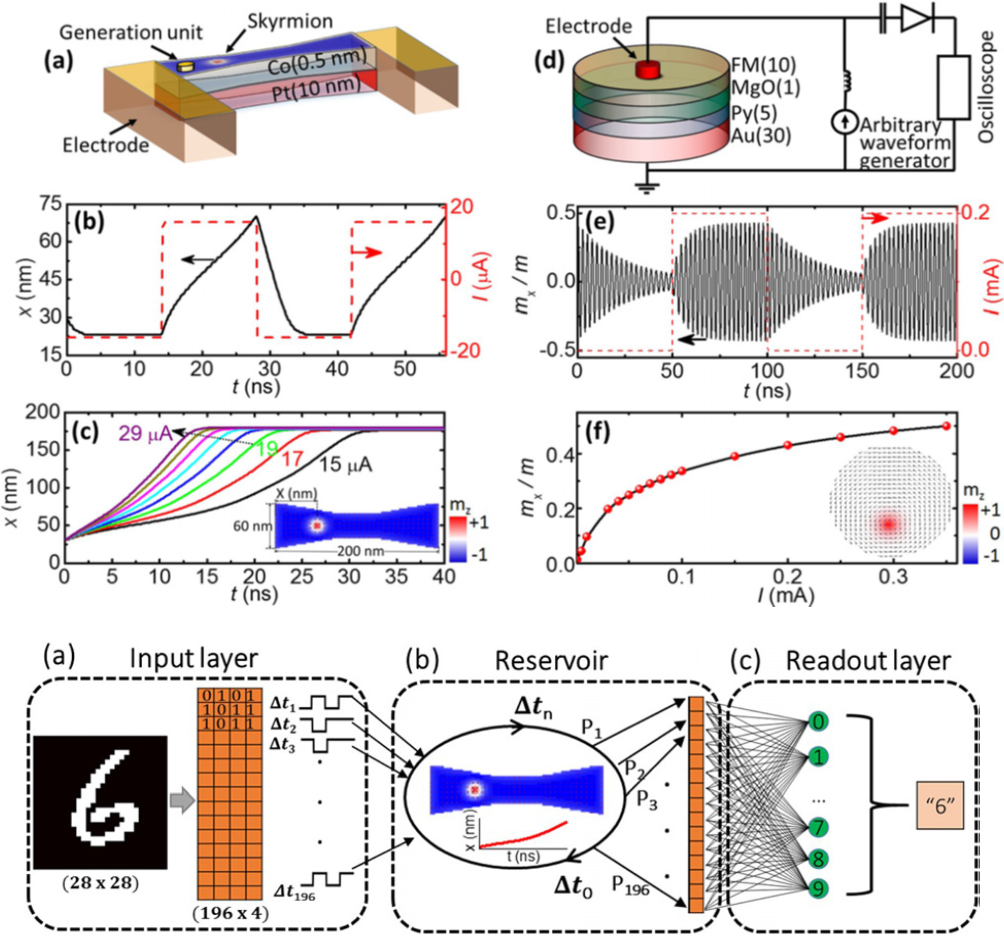 Our work about spin-type neuromorphic computing entitled “Physical reservoir computing using magnetic skyrmion memristor and spin torque nano-oscillator” is published in Applied Physics Letters [Wencong Jiang*, Lina Chen*, Kaiyuan Zhou, Liyuan Li, Qingwei Fu, Youwei Du, and R. H. Liu*, Appl. Phys. Lett. 115, 192403 (2019)]. Congratuations to Mr. Wencong Jiang and Dr. Lina Chen. In this work, we numerically modeled two physical RC systems based on one single magnetic skyrmion memristor (MSM) and 24 spin-torque nano-oscillators (STNOs) to process image classification task and nonlinear dynamic system prediction, respectively. Based on the nonlinear responses of the MSM and STNO with current pulse stimulation, our results demonstrate that the MSM-based RC system exhibits excellent performance on image classification, while the STNO-based RC system does well in solving the complex unknown nonlinear dynamic problems, e.g., a second-order nonlinear dynamic system and NARMA10. Our result and analysis of the current-dependent nonlinear dynamic properties of the MSM and STNO provide the strategy to optimize the experimental parameters in building the better spintronic-based brainlike devices for machine learning based computing.
Our work about spin-type neuromorphic computing entitled “Physical reservoir computing using magnetic skyrmion memristor and spin torque nano-oscillator” is published in Applied Physics Letters [Wencong Jiang*, Lina Chen*, Kaiyuan Zhou, Liyuan Li, Qingwei Fu, Youwei Du, and R. H. Liu*, Appl. Phys. Lett. 115, 192403 (2019)]. Congratuations to Mr. Wencong Jiang and Dr. Lina Chen. In this work, we numerically modeled two physical RC systems based on one single magnetic skyrmion memristor (MSM) and 24 spin-torque nano-oscillators (STNOs) to process image classification task and nonlinear dynamic system prediction, respectively. Based on the nonlinear responses of the MSM and STNO with current pulse stimulation, our results demonstrate that the MSM-based RC system exhibits excellent performance on image classification, while the STNO-based RC system does well in solving the complex unknown nonlinear dynamic problems, e.g., a second-order nonlinear dynamic system and NARMA10. Our result and analysis of the current-dependent nonlinear dynamic properties of the MSM and STNO provide the strategy to optimize the experimental parameters in building the better spintronic-based brainlike devices for machine learning based computing.
_________________________________________________________________________________________________________________________________________________________________________________
2019-09-27
New progress about exploring the complex nonlinear dynamics of SHNOs
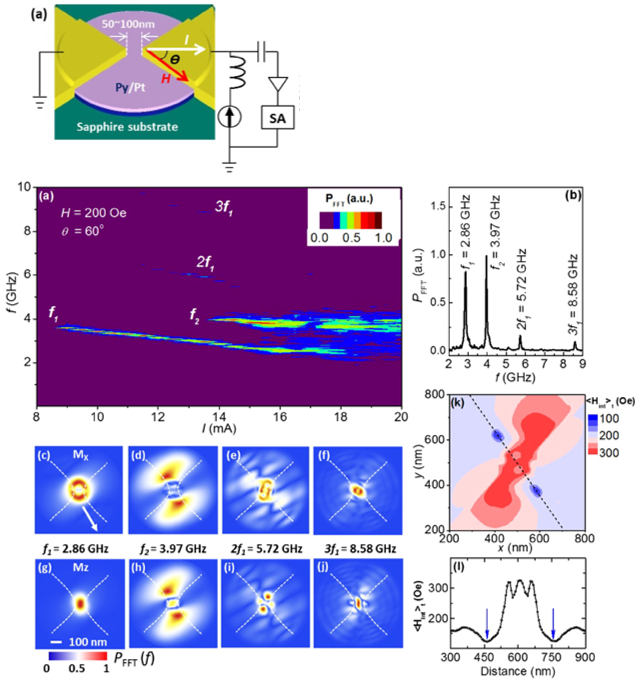 Our new work of spin Hall nano-oscillator entitled “Dynamical mode coexistence and chaos in the nano-gap spin Hall nano-oscillator” is recently published in Phy. Rev. B [Lina Chen, Kaiyuan Zhou, S. Urazhdin, Wencong Jiang, Y. W. Du, and R. H. Liu*, Phys. Rev. B 100, 104436 (2019)]. Congratulations to Dr. Chen. In this paper, we utilize microwave spectroscopy to study the auto-oscillation modes in the nanogap spin Hall nano-oscillators based on Permalloy/Pt bilayers. We show that two distinct spin-wave modes appear in such oscillators, regardless of the magnetic film thicknesses or the size of the electrode gap. We identify the primary mode as a nonlinear self-localized bullet soliton localized at the center of the gap between the electrodes, which is excited over a broad range of currents, field magnitudes, and orientations. The secondary high-frequency mode appears at higher currents and coexists with the primary bullet mode. Micromagnetic modeling shows that this mode is stabilized by the dipolar field of the bullet, and its spatial profile exhibits two maxima offset from the center of the gap in two opposite directions collinear with the field. Simulations also suggest chaotic dynamics that emerges at large currents due to the incoherent coupling between the two modes. Our results demonstrate the possibility to induce and control complex nonlinear dynamical phenomena in spin Hall oscillators, which can be utilized in the emergent neuromorphic and reservoir computing applications. This work is collaborated with Prof. Sergei Urazhdin, Department of Physics, Emory Universty, USA.
Our new work of spin Hall nano-oscillator entitled “Dynamical mode coexistence and chaos in the nano-gap spin Hall nano-oscillator” is recently published in Phy. Rev. B [Lina Chen, Kaiyuan Zhou, S. Urazhdin, Wencong Jiang, Y. W. Du, and R. H. Liu*, Phys. Rev. B 100, 104436 (2019)]. Congratulations to Dr. Chen. In this paper, we utilize microwave spectroscopy to study the auto-oscillation modes in the nanogap spin Hall nano-oscillators based on Permalloy/Pt bilayers. We show that two distinct spin-wave modes appear in such oscillators, regardless of the magnetic film thicknesses or the size of the electrode gap. We identify the primary mode as a nonlinear self-localized bullet soliton localized at the center of the gap between the electrodes, which is excited over a broad range of currents, field magnitudes, and orientations. The secondary high-frequency mode appears at higher currents and coexists with the primary bullet mode. Micromagnetic modeling shows that this mode is stabilized by the dipolar field of the bullet, and its spatial profile exhibits two maxima offset from the center of the gap in two opposite directions collinear with the field. Simulations also suggest chaotic dynamics that emerges at large currents due to the incoherent coupling between the two modes. Our results demonstrate the possibility to induce and control complex nonlinear dynamical phenomena in spin Hall oscillators, which can be utilized in the emergent neuromorphic and reservoir computing applications. This work is collaborated with Prof. Sergei Urazhdin, Department of Physics, Emory Universty, USA.
_________________________________________________________________________________________________________________________________________________________________________________
2019-09-22
Congratulations to Liyuan Li for the Best Poster Prize at 2019 CPS Fall Meeting
Ms. Liyuan Li has been awarded the “Best Poster Prize” at the 2019 Chinese Physical Society Fall Meeting held by Zhengzhou University, Zhengzhou, Henan Province. Congratulations to her!
_________________________________________________________________________________________________________________________________________________________________________________
2019-07-08
Paper published in APL in collaboration with Prof. Dunhui Wang’s group
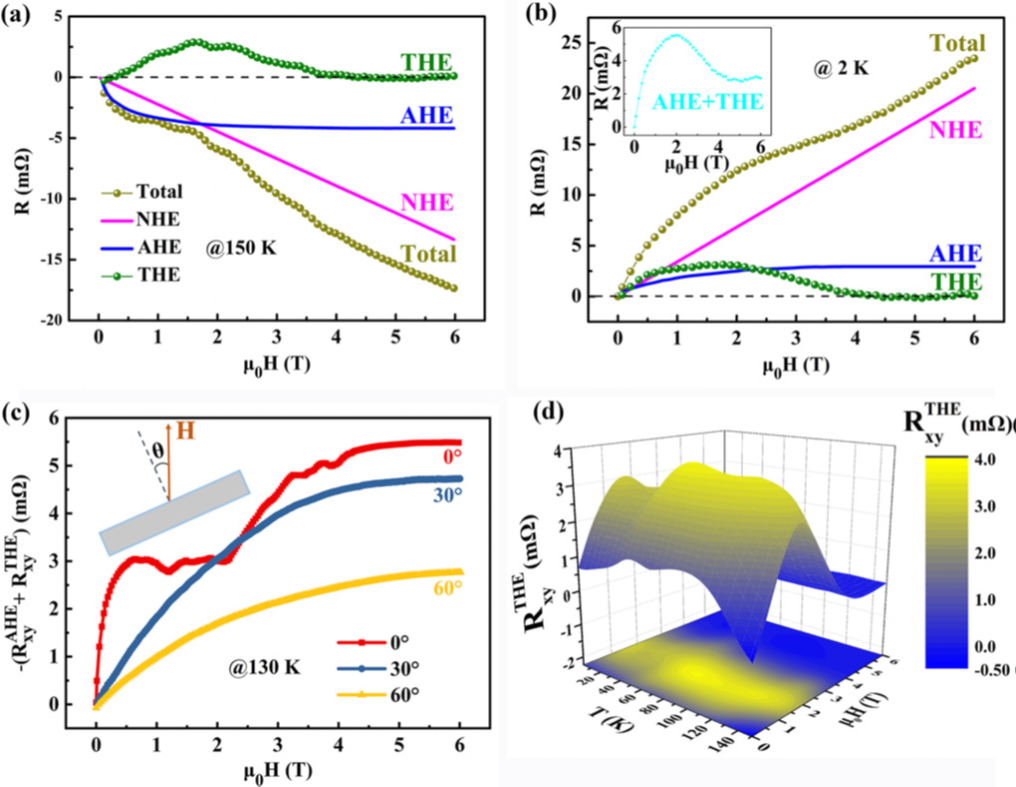
In collaboration with Prof. Dunhui Wang’s group in our Physics Department, We published a paper entitled “Observation of topological Hall effect in antiferromagnetic FeRh film” in APL [Sheng Zhang , Siyu Xia, Qingqi Cao, Dunhui Wang*, Ronghua Liu*, and Youwei Du, Applied Physics Letters 115, 022404 (2019)]. Congratulations to Mr. Sheng Zhang. Noncollinear magnetic structures can give rise to peculiar Hall effects and hold promise for next-generation spintronic devices. In this work, we report the observation of the topological Hall effect (THE) through electrical transport measurements in antiferromagnetic B2-ordered FeRh thin films grown by sputtering techniques on a MgO (001) substrate. Our results opens the possibility to discover the topological Hall effect in centrosymmetric antiferromagnets in contrast to the widely reported B20-type chiral magnets.
_________________________________________________________________________________________________________________________________________________________________________________
2019-06-17
New progress in the dynamical mode coupling and coherence in SHNO with PMA
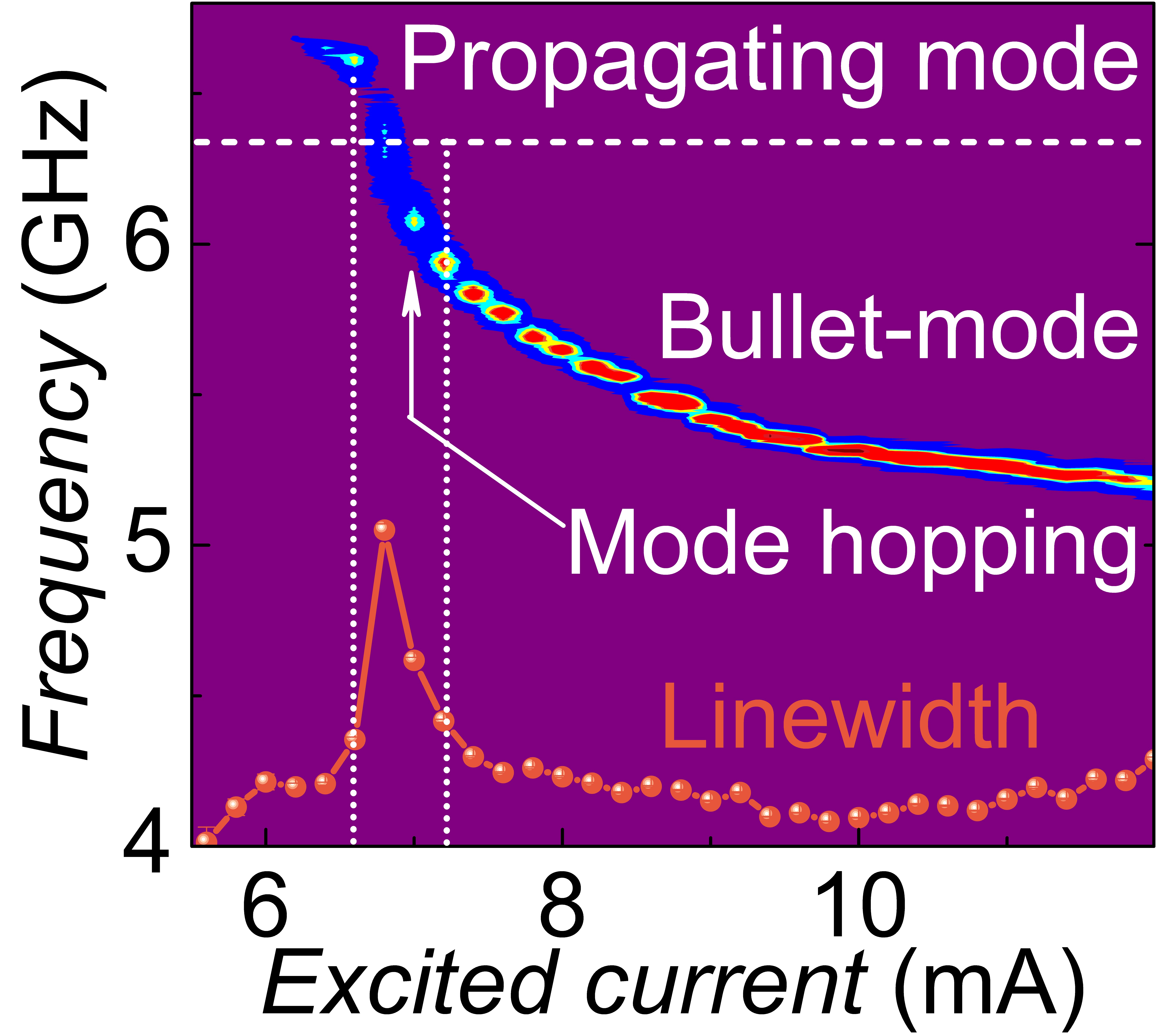
We published a paper entitled “Dynamical Mode Coupling and Coherence in a Spin Hall Nano-Oscillator with Perpendicular Magnetic Anisotropy” in Phy. Rev. Applied [Lina Chen, S. Urazhdin, Youwei Du, and Ronghua Liu*, Physical Review Applied 11, 064038 (2019)]. Controlling dynamical mode coupling in magnetic nano-oscillators is essential to improving their microwave spectral properties for rf applications and neuromorphic computing. This study experimentally demonstrates control of dynamical mode coupling in spin Hall nano-oscillators with perpendicular magnetic anisotropy, by means of temperature, excitation current, and magnetic field. It is established that mode coupling in this system is dominated by thermal magnon-mediated scattering. This work is collaborated with Prof. Sergei Urazhdin, Department of Physics, Emory Universty, USA.
_________________________________________________________________________________________________________________________________________________________________________________
2019-05-09
Paper published in PRB in collaboration with Prof. Di Wu’s group
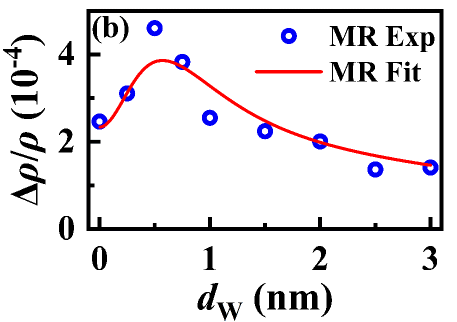
In collaboration with Prof. Di Wu’s group in our Department,We published a paper entitled “Enhanced spin accumulation in metallic bilayers with opposite spin Hall angles” in PRB [Physical Review B 99, 174406 (2019)]. In this work, we investigate the spin Hall magnetoresistance (SMR) in Pt/Y3Fe5O12 (YIG) with a thin W capping layer, in which W and Pt have opposite spin Hall angles. We find an increase of the SMR ratio with a W capping layer thinner than 1.0 nm, which is attributed to the enhancement of the spin accumulation at the Pt/YIG interfacs. Our findings provide a new approach for generating spin accumulation and pure spin current intensity for spintronic applications.
_________________________________________________________________________________________________________________________________________________________________________________
2018-09-16
Congratulations to Qingwei for the Best Poster Prize at 2018 CPS Fall Meeting

Qingwei Fu has been awarded the “Best Poster Prize” at the 2018 Chinese Physical Society Fall Meeting held in Dalian. Congratulations to him!
_________________________________________________________________________________________________________________________________________________________________________________
2017-08-09
Controlling the Spectral Characteristics of a Spin-Current Auto-Oscillator with an Electric Field
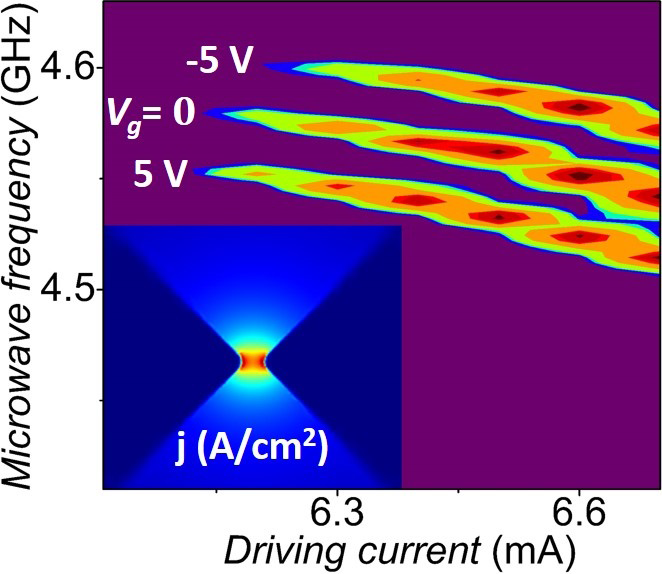
We published a paper entitled “Controlling the Spectral Characteristics of a Spin-Current Auto-Oscillator with an Electric Field” in Phy. Rev. Applied [Physical Review Applied 8, 021001 (2017)]. In this work, we demonstrated that the characteristic currents required for the excitation, the intensity and the spectral characteristics of the generated magnetic nano-oscillation can be tuned by the gate voltage, and the effect of electrostatic gating becomes enhanced in the strongly nonlinear oscillation regime. Electric-field modulation of the current-induced magnetization oscillations and spin waves demonstrated in this work can be utilized for frequency mixing, synchronization, and in logic gates in spin wave-based electronic (magnonic) devices. This work is collaborated with Prof. Sergei Urazhdin, Department of Physics, Emory Universty, USA.
_________________________________________________________________________________________________________________________________________________________________________________